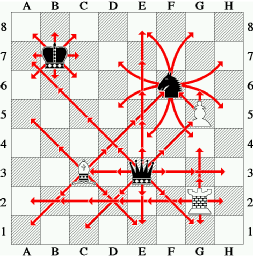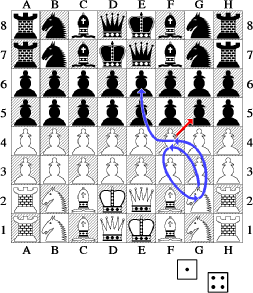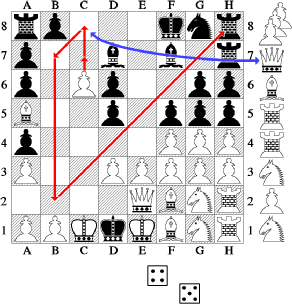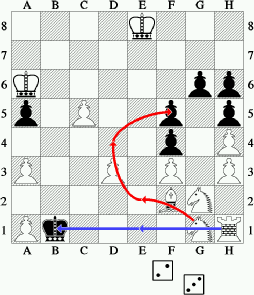Skock
How to play Skock
What is Skock?Skock is the third (and so far, the most playable) in a row of chess variants developed by me and my friend Peter Andersson.To play it, you need one chess board, two sets of pieces and a pair of six-sided dice. The name skock is Swedish and means crowd or herd. It was chosen to describe the crowded look of the board and also because of its likeness to schack, the Swedish name for chess. Setting up the boardYou set up the pieces much like in ordinary chess, except that you double all the rows (see picture 1). Just remember that the white queens stand on white squares and the black queens on black squares. | |
MovingMaking a skock move isn't too complicated. First you throw the two dice. Then, for each die you move one piece the indicated number of steps.Each step must be a legal chess move (see picture 2 for a very compact quick reference). Every step except the last must end on a free square. Consequently, only the last step can be used to take one of your opponent's pieces. Exactly two different pieces must be moved. If you cannot move two pieces, you can't move at all. It is legal to move a piece back and forth or to divide one long step into many short ones, as long as the piece is allowed to move that way. Special chess moves like castling or en passant can't be used in skock. | |
Also, unless you get a double Naturally, White gets to throw first.
Picture 3 shows one way to use a
Note that White would have better off with a
| |
Getting pieces backWhenever a piece is taken, it is put at the end of a queue outside the board. There is one queue for White and one for Black and the pieces are placed in the order they were taken.If a player throws a double, i.e. both dice show the same number, then that player may choose to take that number of pieces from the beginning of the queue and put them back into play, instead of making a normal move. The pieces must be placed as far back as possible. If you are playing White, you must first fill row 1, then row 2 and so on. Within each row, you may place the pieces as you wish. If there aren't enough pieces in the queue, bring back all of them.
Picture 4 shows Black using a double | |
PromotionWhenever a pawn reaches the last row, it can be promoted. In skock that means that you can exchange it with any piece from the queue of taken pieces.If the pawn didn't use up all of its steps, those remaining are transferred to the new piece, which must be able to use them.
Picture 5 shows a white pawn using two steps out of a
| |
WinningTo win a game of skock, you have to take both of your opponent's kings. (Yes, unlike ordinary chess, in this game you can take the kings!) However, you can only take a king using a die that shows a
Picture 6 shows a good example of winning.
First, White uses the | |
|
So, what are you waiting for? Get the board, the dice and the pieces out
and start playing! You don't have two sets of pieces?
Well then, ask a friend to bring some.
After all, you'll need someone to play with.
Or go and make your games dealer's day and buy another box.
Maybe I'll get some inspiration one day and write a computer version to put up here. But don't count on it, it took me five years to put this much together. So many projects, so little time... |
Written by Ulf Göransson ((email removed contact us for address) onet.se).
WWW page created: August 20, 1999.






